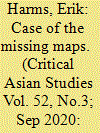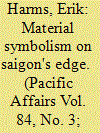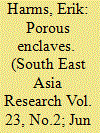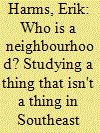|
|
|
Sort Order |
|
|
|
Items / Page
|
|
|
|
|
|
|
| Srl | Item |
| 1 |
ID:
173413


|
|
|
|
|
| Summary/Abstract |
In May 2018, Ho Chi Minh City officials declared that they had lost the original planning maps to the city’s most important urban development project. The case of the missing maps revealed core tensions about urban planning in the city, galvanized popular resistance to city planning authorities, and prompted a series of investigations into government misdeeds. While it is common to criticize maps as artifacts of state power, this case shows how citizens can reappropriate the meaning of maps and transform them into a form of quasi-legal evidence that demands accountability and responsiveness from state officials in a non-democratic single party state. The transformative entanglement of maps and people, however, works reciprocally – just as social groups can transform the meaning of maps, maps also participate in the transformation of social groups. The concept of “cartographic action” seeks to account for the entangled relationship among maps, political life, and social action.
|
|
|
|
|
|
|
|
|
|
|
|
|
|
|
|
| 2 |
ID:
106750


|
|
|
|
|
| Publication |
2011.
|
| Summary/Abstract |
Cities and their fringes are both symbolic and material, imbued with subjective meanings as well as objective physical attributes. In this paper, I show how the physical and social transformation of periurban space in Hô Chí Minh City emerges from and also contributes to a dynamic interaction between symbolic understandings of space as well as material, political economic forces that transform space in concrete ways. On the symbolic level, I show how conceptions of "inside" versus "outside" as well as rural versus urban play into Vietnamese meaning systems that lend a sense of conceptual order and coherence to the larger organization of urban space. In rapidly urbanizing contexts like Hô Chí Minh City, the periurban fringe is dynamic and ever-changing, and the political-economic forces of real-estate speculation, city planning and infrastructure development interact with Vietnamese notions of what an ideal city might look like. This paper shows how periurban spaces in different parts of Hô Chí Minh City can best be understood as spaces of "material symbolism," places where the material attributes of space, the political economy of development, and the symbolic meaning attributed to space all restructure each other in dialectical fashion. Just as symbolic meanings frame how residents perceive these emergent spaces, these same spaces also transform the symbolic meaning of Vietnamese cities.
|
|
|
|
|
|
|
|
|
|
|
|
|
|
|
|
| 3 |
ID:
140849


|
|
|
|
|
| Summary/Abstract |
Cities across Asia are increasingly dotted with large, upmarket, seemingly homogeneous and avowedly exclusive master-planned, mixed-use housing and commercial developments. From an outsider's perspective, these projects appear starkly uniform and to have been imposed on urban landscapes with little attempt to integrate them into local social, cultural and economic contexts. Recent research in South East Asia, however, shows how these developments are not in fact hermetically sealed from the surrounding world. Instead, they may be productively understood as 'porous enclaves', spaces marked not only by exclusion but by social interaction that cuts across the interfaces of inside and outside, public and private, city and country and local and foreign – all categories presumed to be kept separate in many modern city plans. This introductory article to this special issue on 'Porous enclaves' highlights new research at the interface of the porous city and the enclave, and calls on urban studies scholars to pay close attention to the social life within and among the porous enclaves that have emerged in South East Asia.
|
|
|
|
|
|
|
|
|
|
|
|
|
|
|
|
| 4 |
ID:
190142


|
|
|
|
|
| Summary/Abstract |
There is no such thing as a neighbourhood. But neighbourhoods are everywhere. Neighbourhoods are regularly described as things, but we cannot touch them. We typically understand neighbourhoods as places, but we can neither see them nor find their edges. The more one stares at a neighbourhood, the more it seems impossible to see it. Nevertheless, there is something—an often intangible and indescribably social something—compelling us not only to imagine but to experience the neighbourhood being stared at as a real thing. In social science analysis, one important thing that we stare at but cannot see is ‘the social’. To more properly understand the neighbourhood, then, this paper takes the social seriously. It places people and their relationships at the centre of a project to develop a working understanding of the neighbourhood. Instead of asking, ‘What is a neighbourhood?’ the paper suggests that we must always begin by asking, ‘Who is a neighbourhood?’ The empirical basis for the paper's conceptual reflections on the neighbourhood emerge out of a collaborative research project conducted under the auspices of a multicity research project called the Southeast Asia Neighbourhoods Network.
|
|
|
|
|
|
|
|
|
|
|
|
|
|
|
|
|
|
|
|
|